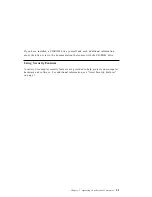
can remotely monitor and control your PC. DMI can be used to remotely track
many types of information about networked PCs, including serial numbers, memory
attributes, product-specific characteristics of installed peripherals, and operating
system configuration information. This information can be accessed using a DMI
browser. DMI browsers are provided by all major operating systems and all major
LAN management packages (including TME 10 NetFinity, Intel LAN Desk, and
Microsoft SMS).
Your computer also has system-management hardware and software that provides
power, temperature, fan speed, and chassis intrusion information that is accessible
from a DMI browser.
The Wake on LAN feature can be used by a network administrator to turn on your
PC from a management console. When Wake on LAN is used in conjunction with
network-management software, such as TME 10 NetFinity Version 4 (provided on
the Ready-to-Configure CD that comes with your computer), many types of functions,
such as data transfers, software updates, and POST and BIOS updates can be
performed remotely on your PC and other computers enabled for Wake on LAN
that are linked to your network. This updating can be done after hours and on
weekends, which saves time and increases productivity. Users are not interrupted
during normal working hours and LAN traffic is kept to a minimum. Refer to
“Wake on LAN” on page 54 for further information.
Other features such as remote program load (RPL) and dynamic host configuration
protocol (DHCP) also allow a network administrator to remotely control your
computer. If you use remote program load in conjunction with LANClient Control
Manager software, you can use a feature called Hybrid RPL. Using LANClient
Control Manager, you set up your computer by installing hybrid images (or files) on
the hard disk drive. Then, each time the computer starts from the network,
LANClient Control Manager recognizes your computer as a Hybrid RPL client and
a bootstrap program is downloaded to your computer. This bootstrap program is
small and helps prevent network congestion. Working off the hybrid images, the
bootstrap program initiates the startup process from the hard disk drive of your
computer. An advantage to Hybrid RPL is that the network load associated with
standard RPL is avoided. Refer to “RPL and DHCP” on page 53 for further
information.
System Programs
System programs are the basic layer of software built into every IBM PC. They
include the power-on self test (POST), the basic input/output system (BIOS) code,
and the Configuration/Setup Utility program. POST is a set of tests and procedures
that is performed every time you turn on your PC. The BIOS is a layer of software
26
Using Your Personal Computer
Summary of Contents for PC 300PL Types 6862
Page 1: ...Personal Computer Using Your Personal Computer PC 300PL...
Page 2: ......
Page 3: ...Personal Computer Using Your Personal Computer PC 300PL IBM...
Page 12: ...x Using Your Personal Computer...
Page 46: ...32 Using Your Personal Computer...
Page 70: ...56 Using Your Personal Computer...
Page 145: ......
Page 146: ...IBM Part Number 06J0871 Printed in U S A July 1997 6J 871...
















































